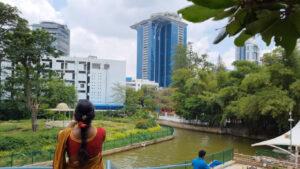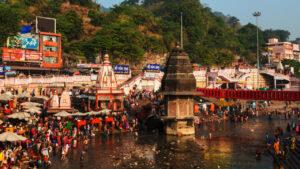Char Dham Yatra, a revered pilgrimage for Hindus, encompasses four sacred sites in the Himalayas: Yamunotri, Gangotri, Kedarnath, and Badrinath. Journey is not just a physical pilgrimage; it’s a spiritual experience, attracting millions of devotees and travelers seeking to deepen their spiritual connection. For many, the quest to visit these divine sites can be challenging due to the remote and rugged terrain. Fortunately, a Char Dham Yatra tour package by helicopter provides a convenient and exhilarating way to experience these sacred destinations.
Also Read: Top 11 Famous Temple in Puri
Char Dham Yatra itinerary and guide you on how to book a helicopter Char Dham Yatra package.
Significance of Char Dham
Char Dham, translated as “Four Abodes,” consists of:
- Yamunotri: Source of the Yamuna River, dedicated to Goddess Yamuna, known for its thermal springs and sacred shrines.
- Gangotri: Origin of the Ganges River, dedicated to Goddess Ganga. Temple is believed to be where Lord Shiva accepted the Ganga to save the Earth from her force.
- Kedarnath: One of the twelve Jyotirlingas dedicated to Lord Shiva, located in the majestic mountains of Uttarakhand.
- Badrinath: Significant shrine dedicated to Lord Vishnu, surrounded by high peaks and offering breathtaking views.
Significance of these temples transcends the physical realm and delves into spirituality, making this yatra a sought-after experience.
Char Dham Yatra Itinerary
Planning a Char Dham Yatra can be overwhelming, given the vast distances and challenging terrains involved. Below is a suggested itinerary for a helicopter Char Dham Yatra that spans approximately 5-6 days. Itinerary balances comfort with devotion, ensuring you can spend quality time at each shrine.
Four Dhams in India
- Badrinath (Uttarakhand)
- Dwarka (Gujarat)
- Puri (Odisha)
- Rameswaram (Tamil Nadu)
Puri is one of the four sacred destinations in the Char Dham Yatra. If you want to visit one of the Char Dhams, Puri is a must-visit destination! 🌟 Book your trip now and explore the spiritual heart of Odisha.
Popular puri tour packages include (1) 2 night 3 days puri package (2) 3 night 4 days puri package (3) 4 night 5 days puri package (4) Couple Tour Package (5) Family Tour Package (6) Puri Sightseeing tours
Day 1: Arrival in Dehradun
- Arrival at Dehradun: Begin your journey in Dehradun, the capital of Uttarakhand. Upon your arrival, you will be received by your tour operator who will assist you in reaching your hotel.
- Accommodation: Check into your pre-booked hotel and relax after your journey.
- Orientation: In the evening, have a briefing about the Char Dham Yatra itinerary, safety protocols, and what to expect on your trip.
Day 2: Dehradun to Yamunotri (by Helicopter)
- Early Morning Departure: Start early with a helicopter ride to Yamunotri from Dehradun. The journey is about 30 minutes, offering picturesque views of the Himalayas.
- Yamunotri Temple Visit: Upon reaching Yamunotri, trek about 5 km to reach the Yamunotri Temple. Enjoy the hot springs and pay your respects to Goddess Yamuna.
- Return to Dehradun: Return to the helipad and fly back to Dehradun for your overnight stay.
Day 3: Dehradun to Gangotri (by Helicopter)
- Dehradun to Gangotri Flight: After breakfast, take a helicopter from Dehradun to Gangotri. The flight duration is approximately 30-45 minutes.
- Gangotri Temple Visit: Upon arrival, visit the Gangotri Temple and experience the divine ambiance surrounding it. Temple is nestled amidst majestic mountains and is a sight to behold.
- Evening Reflection: Spend the evening by the banks of the river Bhagirathi, reflecting on the day’s spiritual experiences.
- Overnight Stay in Gangotri: Stay at the hotel or guesthouse in Gangotri.
Day 4: Gangotri to Kedarnath (by Helicopter)
- Morning Schedule: Begin your day with an early helicopter ride to Kedarnath. Aerial journey will take you to the majestic heights of Kedarnath within a short span of 25-30 minutes.
- Kedarnath Temple Visit: Upon reaching, visit the Kedarnath Temple, one of the holiest shrines dedicated to Lord Shiva. Experience the serenity and the presence of the divine in the backdrop of snow-clad mountains.
- Local Exploration: Spend some time exploring the nearby areas. Optionally, you may choose to go to the nearby Bhairav Temple.
- Return to your stay: Stay overnight in Kedarnath in available accommodations.
Day 5: Kedarnath to Badrinath (by Helicopter)
- Connecting Flight: Start your day with a helicopter ride from Kedarnath to Badrinath, which will take approximately 30 minutes.
- Badrinath Temple Visit: After landing, visit the revered Badrinath Temple, dedicated to Lord Vishnu. The temple offers mesmerizing views and an aura of spirituality.
- Tapt Kund Visit: Don’t miss bathing in the Tapt Kund hot springs, which is believed to wash away sins and provide divine blessings.
- Evening Aarti: Participate in the evening Aarti ceremony, which is a captivating experience filled with devotion and energy.
- Overnight Stay in Badrinath: Overnight stay in Badrinath.
Day 6: Return to Dehradun
- Departure from Badrinath: After breakfast, take a helicopter back to Dehradun from Badrinath.
- Final Departure: Upon arrival in Dehradun, you can either head to the airport or continue your journey to nearby iconic locations in Uttarakhand or simply head back home.
Booking a Char Dham Yatra Tour Package by Helicopter
Booking a helicopter Char Dham Yatra package has never been easier, thanks to several tour operators who specialize in pilgrimage travel. Here are some steps you can take to book your tour:
1. Choose a Reputable Tour Operator
Start by researching and selecting a reliable tour operator that specializes in the Char Dham Yatra. Look for operators that have good reviews, experienced guides, and offer flexible itineraries. It is also advisable to compare prices and services.
2. Customize Your Package
Most tour operators offer charter packages that you can customize according to your preferences. You might want to include additional sightseeing options or accommodations that suit your needs.
3. Plan Ahead
Char Dham Yatra is immensely popular, especially during the peak pilgrimage season (typically from late April to November). It is highly recommended to book your helicopter tour package in advance to secure your seats and accommodations.
4. Make a Consultation
Most tour operators will offer free consultations where you can ask questions and discuss your itinerary. Use this opportunity to inquire about safety measures, adherence to health protocols, and the specifics of the helicopter ride.
5. Payment and Confirmation
Once you have finalized your package, you will be required to make a payment. Ensure you receive a confirmation invoice, which should detail your itinerary, accommodations, and any other pertinent information.
6. Preparing for the Yatra
With your booking confirmed, prepare for your journey. Carry essentials like warm clothing, comfortable shoes, necessary personal items, and your essential documents. It is also prudent to consult with your doctor if you have any health concerns, especially considering the altitude of some locations.
Benefits of Taking a Helicopter Char Dham Yatra
Helicopter Char Dham Yatra tour comes with several advantages that enhance the overall experience:
- Time-Saving: Helicopter reduces the travel time to each destination significantly. This way, you can spend more time at the shrines, reflecting, and connecting spiritually.
- Convenience: Helicopter services bypass the physically demanding treks, making the pilgrimage accessible to individuals of all ages, including the elderly and those with mobility issues.
- Breathtaking Views: Aerial views of the pristine landscapes of the Himalayas offer a unique perspective, allowing visitors to appreciate the natural beauty of the region.
- Spiritual Experience: Convenience of helicopter service allows for a more relaxed and contemplative experience at each sacred site.
Char Dham Yatra is not just a religious journey; it is an exploration of self, spirituality, and nature. By choosing a Char Dham Yatra tour package by helicopter, pilgrims can navigate the sacred landscapes of Yamunotri, Gangotri, Kedarnath, and Badrinath with ease and comfort.
With careful planning, the right itinerary, and a reliable tour operator, you can make your Char Dham Yatra memorable and spiritually rewarding. Embark on this divine pilgrimage and discover the profound sense of peace and connection that awaits you in the serenity of the sacred temples.







